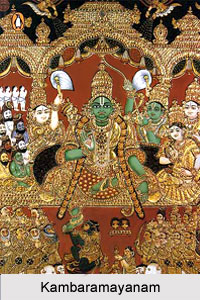 Kambaramayanam, also known as Kamba Ramayanam or Kamparamayana or Ramavataram is a Tamil epic which was composed by the renowned poet Kambar, also known as Kampan or Kamban during the 12th century. Kambaramayanam was based on the original Sanskrit epic titled Ramayana which was written by the Sage Valmiki. The Indian epic narrates the tale of Rama of Ayodhya, a Raghuvamsa prince. Sita, his wife, is abducted by the demon Lord Ravana, the king of Lanka. But Kambaramayanam is much different from the Sanskrit version in several aspects, particularly in the spiritual concepts and the plotline as well. Kambar composed the Tamil epic with the support of a Pannai kula chieftain, known as Thiruvennai Nallur Sadayappa Vallal. The poet refers to his name once in every one thousand verses as a sign of appreciation.
Kambaramayanam, also known as Kamba Ramayanam or Kamparamayana or Ramavataram is a Tamil epic which was composed by the renowned poet Kambar, also known as Kampan or Kamban during the 12th century. Kambaramayanam was based on the original Sanskrit epic titled Ramayana which was written by the Sage Valmiki. The Indian epic narrates the tale of Rama of Ayodhya, a Raghuvamsa prince. Sita, his wife, is abducted by the demon Lord Ravana, the king of Lanka. But Kambaramayanam is much different from the Sanskrit version in several aspects, particularly in the spiritual concepts and the plotline as well. Kambar composed the Tamil epic with the support of a Pannai kula chieftain, known as Thiruvennai Nallur Sadayappa Vallal. The poet refers to his name once in every one thousand verses as a sign of appreciation.
The epic of Kambaramayanam is quite significant in the history of Tamil literature for its vibrant poetry and religious and spiritual value and is also popular in the Hindu spiritual world. Ramavataram or Kambaramayanam is regarded as one of the greatest literary works in Tamil literature by Tamil scholars and general Tamil citizens.
Composition of Kambaramayanam
Kambaramayanam, also known as Kamparamayana, by Kambar is an epic composed of more than eleven thousand poems, as opposed to 24000 verses of Sanskrit Ramayana. It was initially known as Rama Avataram or Rama Kathai. The epic work was accepted into the holy precincts in the attendance of Vaishnava Acharya Shriman Nathamuni. The Kambaramayanam is not simply a translation of the Sanskrit Ramayana by sage Valmiki, but an original work that restates the tale of Lord Rama. The poetic work is much accepted for its similes. According to legends, Lord Ganesha composed the hymns that were dictated by the Tamil poet Kambar. It is widely believed that Lord Ganesha wrote the entire episode in a single night, as Kambar postponed the work of the Tamil epic till the next day before the time limit set by the Chola King.
The implementation of viruttam and santham in several verses is effectual in conveying the emotion and feel for plot. Kambar achieves the viruttam and santham by efficient choice of words. The work of Ramavataram or Kambaramayanam consists of almost twelve thousand hymns and almost forty five thousand lines of pleasant verses and poems that make the literary work as one of the greatest epic in Tamil literature.
Structure of Kambaramayanam
There are 6 main chapters in Kambaramayanam known as Kandam in Tamil language. These chapters include-
* Bala Kandam- Childhood Chapter
* Ayodhya Kandam- Ayodhya Chapter
* Aranya Kandam- Forest Chapter
* Kishkindha Kandam- Kishkindha Chapter
* Sundara Kandam- Beautiful Chapter
* Yudha Kandam- War Chapter
The six chapters or Kandams are further segmented into one hundred and twenty three segments known as Padalam in Tamil. These segments comprises of more than eleven thousand verses of Kambaramayanam.













